CGH Earth’s Coconut Lagoon: Ecolabelling Report
Posted OnIntroduction
The Coconut Lagoon Heritage Resort in Kumarakom, Kottayam district, Kerala commissioned the Green Signal to provide it with an ecolabel rating, which was determined to be 4 bars out of 5.
The ecolabelling process is based on these three areas of investigation, verification, and documentation: GHG inventory assessment of the hotel (with respect to energy, water, waste, mobility, and materials), the conservation practices (of materials, waste, water, and energy) within the hotel, and the sustainability initiatives promoted/operated by the hotel.
Consolidated Activity Data and GHG Inventorying – FY 2011-12
Total annual GHG emissions: 1210.9 MT CO2e/year
Total annual overnight stays for FY 2011-2012 is 10,138, and the GHG emissions per overnight stay (all emission scopes) is 119 kg C02e/overnight stay:
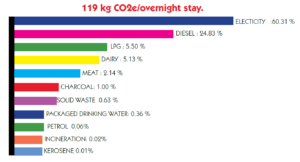
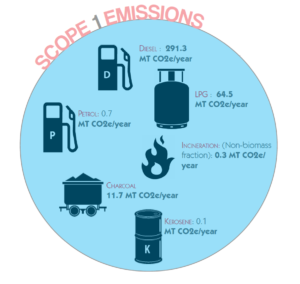
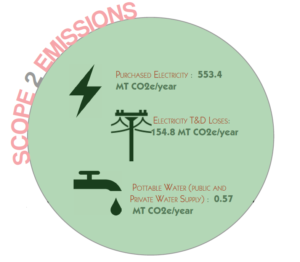
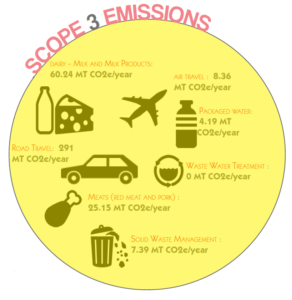
Only taking into account Scope 1 and 2 emissions, the GHG emissions per stay are 106 kg CO2e/overnight stay, meaning that Coconut Lagoon has lower GHG emission than 87% of 5 star hotels in the Warm & Humid Agro-Climatic Zone.
Positive Environmental Impacts
Waste Reduction and Management
Waste Reduction:
-Paper reductions – newspapers aren’t delivered to each room; rather there’s common reading material provided in congregation areas. Reusable cloth bags are used as bin liners in guest rooms.
-Plastic reductions – Use of plastic packing for supplies coming onto the property by vendors is prohibited (vendors are required to package material in reusable containers/jars). Bottled water suppliers are asked to take back empty PET bottles, and soap/shampoo containers are made from terracotta.
-Other – Organic paddy cultivates eliminates the use of fertilizer and pesticides and reduces water use.
Low Embodied Carbon/recycled materials:
-Recycled paper is used for all communication materials, guest amenities, and restaurant menus.
-The on-site school for the staff’s children is built from recycled PET bottles.
-90% of BUA is comped of re-assembled ‘Tharavad’ houses.
-All laundry detergent, soaps, and shampoos are biodegradable (so that wastewater treatment plants work properly). Organic pesticides are used rather than conventional ones.
Biodegradable/non-biodegradable waste:
-Cooking waste is processed by conversion into methane by a biogas plant.
-Dry leaves are composted in bamboo bins using slurry from from the biogas as a bio-catalyst, and the resulting compost is used for farming.
-Coconut husks and other organic materials not suitable for biogas processing are composted on-site and then used for farming.
-Non-biodegradable waste is segregated and sold to scrap dealers for recycling; near 100% recycling is achieved for the majority of waste categories.
-Paper waste is recycled for envelopes, and construction material refuse is used for the construction of walking pathways. Old cloth refuse and bed linen are donated to local orphanages.
Water related practices
-Wastewater is treated by a sewage treatment plant using Expanded Granular Sludge Bed Reactor (EGSBR) and filtration technology and the effluent is used for gardening purposes.
-Push-taps are installed in staff quarters and messes and guest bathrooms are equipped with dual-cistern flush systems reduce water consumption. Instead of a conventional lawn, an indigenous variety of Buffalo Grass is used that requires less water, curbs evaporation, and enhances groundwater recharge.
-Rainwater harvesting means that Coconut Lagoon’s operation during monsoon season is entirely water self-sufficient (additional water–2700 kilos–is sourced from tankers only during the summer months of March to June).
Energy related practices
Energy efficiency:
-Lighting is more efficient because CFL bulbs are used in the gardens, and LED and T5, T8 tubelight fixtures with electronic ballots are used elsewhere.
-HVAC – the use of 30 TR VRF systems account for 22% of the total tonnage, and 28 split-unit systems of 2.2 TR capacity have an EER greater than 2.92.
-Has naturally lit and naturally ventilated restaurants; all guest rooms and bathrooms are designed to maximize natural light and ventilation.
-Capacitor banks are installed to achieve power factor improvement; power saver technology is used in all 50 rooms.
Renewable Energy Practices
-A solar thermal network supplies the hot water requirement (13,000 liters per day) for 50 guest rooms and the kitchen.
-A 2kW Solar PV on one of the guest transport boats comprises 0.50% of total connected load.
-A biogas-run cooker, running on methane from the biogas plant with a calorific value equivalent to 17kgs of LPG a day, can cook 80 kgs of rice per day. Excess methane from the biogas plant and EGSB reactors not used for cooking purposes is used to power street lamps that would have a combined load of 500 watts under normal conditions.
Sustainability Practices
Food Procurement Practices
-59.47% of annual food procurement cost comes from within the state, and 0.46% annual food procurement is spent on organic food.
Economic, Social, and Environmental Development Practices
-80% of unskilled labor comes from the community, and cloth laundry bags, paper bags, envelopes from newspapers, and terracotta waste bins are all manufactured locally.
-Coconut Lagoon has adopted two local schools and financially supports their maintenance work, station, and study materials and resources.
-Waste bins are provided for the 180 families (1 per 10 families) in the village.
-Dry waste from community bins is collected weekly for recycling, and cloth bags are distributed in the local community every 3 months as part of a ‘Plastic Eradication Programme.’ CFL bulbs are distributed within the community as well for household use.
-Staff members lead monthly clean up drives and conduct periodic environmental education classes in adopted local schools (students also take field trips to study Coconut Lagoon’s green practices). Earth Hour awareness programs are also held within the local community, as are community tree plantation drives.
Engagement in Sustainable Tourism Initiatives
-Guests are encouraged to participate in biodiversity appreciation initiatives, and an in-house naturalist at the Interpretation Centre can educate them on the ecology of the region.
-Guests are also encourage to participate in the organic rice plantation and cultivation activities as well as the tree plantation initiatives in the surrounding area.
Biodiversity Preservation Initiatives
-Coconut Lagoon has a total of 1101 trees representing 90 different species on its property.
-It also has a butterfly garden with 17 different species and a fish sanctuary with 44 different species.
-Mangrove saplings have been planted along the waterside as an effort to restore rapidly disappearing mangroves as well as spread awareness about their importance to the community.
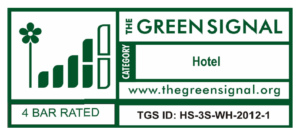
The original report can be read here.